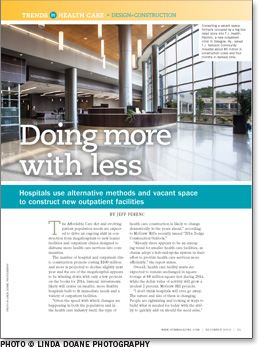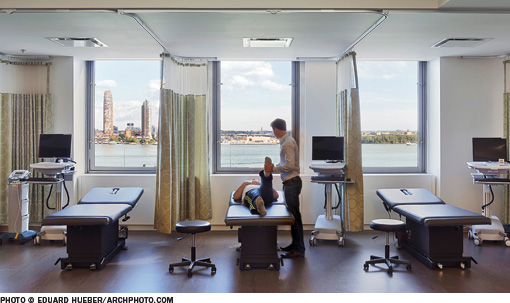
The Affordable Care Act and evolving patient population needs are expected to drive an ongoing shift in construction from megahospitals to new leaner facilities and outpatient clinics designed to disburse more health care services into communities.
The number of hospital and outpatient clinic construction projects costing $100 million and more is projected to decline slightly next year and the era of the megahospital appears to be winding down with only a few projects on the books for 2014. Instead, investments likely will center on smaller, more flexible hospitals built to fit immediate needs and a variety of outpatient facilities.
"Given the speed with which changes are happening in both the population and in the health care industry itself, the type of health care construction is likely to change dramatically in the years ahead," according to McGraw Hill's recently issued "2014 Dodge Construction Outlook."
"Already there appears to be an emerging trend for smaller health care facilities, as chains adopt a hub-and-spoke system in their effort to provide health care services more efficiently," the report states.
Overall, health care facility starts are expected to remain unchanged in square footage at 68 million square feet during 2014, while the dollar value of activity will grow a modest 2 percent, McGraw Hill projects.
"I don't think hospitals will ever go away. The nature and size of them is changing. People are rightsizing and looking at ways to build what is needed for today with the ability to quickly add on should the need arise," says Curtis Skolnick, managing director, CBRE Healthcare, Richmond, Va.
"What we're seeing is a move to build hospitals only for what's needed today, very little shell space, rightsizing things with very tight spaces. We are attempting to build hospital chassis that to some degree are future-proof," Skolnick says.
Jeff Stouffer, AIA, principal and incoming director of the HKS health care group, Dallas, agrees that new hospitals are scaling back in size and scope and usually incorporate Lean principles to cut costs. "We're still seeing some new construction and expansions, but they are just fewer and farther between for acute care hospitals," he says.
A trend grows
John Kouletsis, vice president of planning and design, Kaiser Permanente, Oakland, Calif., says the paradigm shift of making affordable, accessible health care the norm impacted new health care facilities even before the Affordable Care Act.
"The main drivers for many years have to do with ease of access, meeting expectations of the patients and their families, to offer high quality care. One of the biggest issues has been affordable care," he says. "There's a huge move to providing care in the outpatient world and in the lowest acuity building possible."
Jean Mah, FAIA, FACHA, LEED AP, global health care practice leader, Perkins + Will, Los Angeles, agrees that the outpatient facility trend has been increasing for some time already and will continue to grow with the Affordable Care Act.
The data support the shift in health care facility type. According to the American Hospital Association (AHA), inpatient admissions rose from 117 per 1,000 persons in 1996 to 120 admissions per 1,000 in 2003 and then started declining to 116 admissions per 1,000 in 2009. Meanwhile, outpatient visits rose from nearly 1,700 per 1,000 persons in 1996 to more than 2,000 visits per 1,000 persons in 2009, AHA says.
Research firm IBIS World, New York City, reports there are 29,440 total emergency, outpatient and ambulatory facilities in the United States today. To meet the anticipated demand for more outpatient care, the number of those facilities is projected to grow to about 31,400 by 2018, a 6.7 increase over the next five years.
Commercial real estate services firm Jones Lang LaSalle, Chicago, declared in a recent report that in the new patientcentric era of health care, the spoke – or outpatient facility – will become as important as the hub, or central hospital.
Chris Masloroff, vice president, national health care practice, Jones Lang LaSalle Americas Inc., Chicago, says outpatient facilities offer benefits for patients and health care organizations, including helping to build organization brand in addition to increasing accessibility.
The number of Medicare-certified ambulatory surgery centers (ASCs) soared from 2,171 in 1996 to 5,364 this year, though the increase has slowed the past few years, according to the Ambulatory Surgery Center Association. The number of ASCs overall is estimated at 6,400, the association says.
Jones Lang LaSalle reports that from 1998 to 2008 the percentage of total hospital gross revenue attributed to outpatient activity increased from 21 to 39 percent. Outpatient visits are expected to grow by more than 20 percent by 2019, generating increased revenue right along with the growth, the firm states.

Old method, new application
It's not just the type of health care facility that is changing, it's also the way some are being built and designed. The use of modular, prefabricated construction, a decades-old method, is gaining acceptance in the health care industry beyond use in temporary or quick-response facilities, explains Andrew Quirk, senior vice president and national director, Healthcare Center of Excellence, Skanska USA Inc., New York City.
Rather than building a new facility from scratch on-site as in traditional
construction, Skanska hires local
workers to assemble entire exam rooms, surgery rooms, patient washrooms, head walls and more off-site using the prefabricated method.
The sections, which include mechanical, electrical and plumbing components, are assembled in vacant warehouses or factories. The finished units are loaded onto trucks and delivered to the building site, which usually is only a few miles away, and moved by a crane, Quirk says.
Prefabricated construction achieves the all-important speed-to-market objective by reducing construction time by up to 30 percent, cuts cost and improves quality control, Quirk says. It's sustainable, too — it nearly eliminates any construction waste because the materials in the units are sized to fit, he adds.
Quirk says Skanska is incorporating prefabricated construction into smaller facilities as well as parts of the $700 million, 1.5 million-square-foot University Medical Center, New Orleans, which eliminates any doubts of its limitations.
Calling it "the future of health care facility construction," he foresees the day when nearly entire medical facilities will be prefabricated in a factory, delivered to the job site and built in a matter of days, rather than years.
Another option for health care systems seeking to build in the community, is the abundance of vacant retail and office space across the nation, much of it a fallout from the Great Recession. Adaptive reuse offers an additional opportunity to reduce cost and construction time.
One success story — the T.J. Health Pavilion — involves a vacant retail space in Glasgow, Ky., that was converted into a combination medical office building and outpatient clinic with such services as urgent care, diagnostic imaging, women's care and more. The 226,800-square-foot facility also includes a community center and indoor walking track.
T.J. Samson Community Hospital, Glasgow, needed to consolidate its physician groups and relieve parking congestion on its main campus, so it built the multipurpose facility a few miles away from the hospital.
The retail space was gutted and redesigned for clinical use and a new three-story medical office was built in front. The result is a contemporary-looking, highly visible, energy-efficient health care facility with a geothermal HVAC system that merges clinical space with community use, says Paul Edwards, principal, Stengel Hill Architecture, Louisville, Ky.
"We certainly proved in this instance that vacant retail is a good fit," Edwards says of the project. He estimates the hospital saved about $5 million and four months' construction time by building in the vacant retail space.
Mah of Perkins + Will says utilizing vacant spaces offers flexibility and a new level of sustainability. "You can lease a space for a number of years and then you can grow it by leasing more adjacent space," she says. If necessary, the facility can move to a new location as the market changes, she adds.
Design objectives
As for design, the priorities are about making staff workflow and patient throughput as efficient as possible. Utilizing modularity and demountable partitions that can be reconfigured in the same space or moved to another one are important design objectives.
"The more it's about systems and components the easier it is to use somewhere else, which is highly sustainable," Mah says.
Stouffer says patient and family experiences are priorities, which make staff efficiency and decreased patient waiting time critical. HKS has a consulting group comprising former clinicians within its company that collaborates on projects with clients before the firm designs the facility.
"The building can't resolve all of your operational conflicts. But you want to eliminate any barriers the building could pose, which is why we design the operations first and then we create the buildings to support the operations," he says.
Mah says design focuses on applying or extending the brand of the health care system or provider through image and identity development in each space. Among the firm's key design initiatives are daylighting; use of sustainable, durable materials; and the design of collaborative work areas for clinical staff.
On the forefront of the decentralized, patient-centric health care movement, Kaiser Permanente is in the process of rolling out about 30 clinics that will offer care for a high percentage of minor ailments that cause persons to seek care, Kouletsis says.
There's more. He says that Kaiser Permanente also is analyzing the potential of converting out-of-use shipping containers to build clinics, figuring that if they can be used for the latest trendy residential space why not health care, too?
"Could we take a shipping container, convert that into a clinic and have that open in an underserved community within weeks rather than months or years? We are looking at that as a possibility," he says.
It all fits with the health care organization's new mantra of care anywhere. "We will not stop building hospitals, but what we build will continue to be based on the changing world of what the patient wants and what technology can do for us to provide easily accessed care that's high-quality and affordable," he says.
Mah welcomes the era of the smaller, more sustainable health care facility. "I personally find it very exciting that we, hopefully, can do more with less — less real estate, less operations, less construction costs," she says.
Jeff Ferenc is senior editor of Health Facilities Management.





